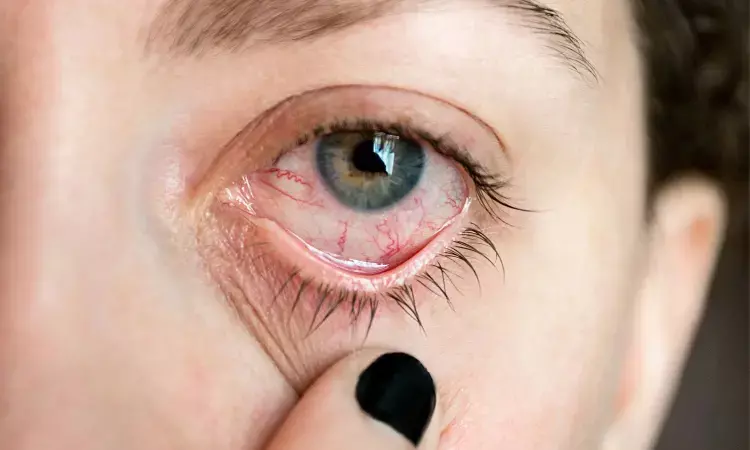- Home
- Medical news & Guidelines
- Anesthesiology
- Cardiology and CTVS
- Critical Care
- Dentistry
- Dermatology
- Diabetes and Endocrinology
- ENT
- Gastroenterology
- Medicine
- Nephrology
- Neurology
- Obstretics-Gynaecology
- Oncology
- Ophthalmology
- Orthopaedics
- Pediatrics-Neonatology
- Psychiatry
- Pulmonology
- Radiology
- Surgery
- Urology
- Laboratory Medicine
- Diet
- Nursing
- Paramedical
- Physiotherapy
- Health news
- Fact Check
- Bone Health Fact Check
- Brain Health Fact Check
- Cancer Related Fact Check
- Child Care Fact Check
- Dental and oral health fact check
- Diabetes and metabolic health fact check
- Diet and Nutrition Fact Check
- Eye and ENT Care Fact Check
- Fitness fact check
- Gut health fact check
- Heart health fact check
- Kidney health fact check
- Medical education fact check
- Men's health fact check
- Respiratory fact check
- Skin and hair care fact check
- Vaccine and Immunization fact check
- Women's health fact check
- AYUSH
- State News
- Andaman and Nicobar Islands
- Andhra Pradesh
- Arunachal Pradesh
- Assam
- Bihar
- Chandigarh
- Chattisgarh
- Dadra and Nagar Haveli
- Daman and Diu
- Delhi
- Goa
- Gujarat
- Haryana
- Himachal Pradesh
- Jammu & Kashmir
- Jharkhand
- Karnataka
- Kerala
- Ladakh
- Lakshadweep
- Madhya Pradesh
- Maharashtra
- Manipur
- Meghalaya
- Mizoram
- Nagaland
- Odisha
- Puducherry
- Punjab
- Rajasthan
- Sikkim
- Tamil Nadu
- Telangana
- Tripura
- Uttar Pradesh
- Uttrakhand
- West Bengal
- Medical Education
- Industry
Non-segmental vitiligo closely related to ocular problems: Study

Egypt: Ocular alterations are more likely to occur in those with non-segmental vitiligo states a study published in the Australasian Journal of Dermatology.
About 1% of people worldwide suffer from vitiligo, which is characterized by white lesions on the skin. About 90% of vitiligo instances are nonsegmental, which typically appears gradually throughout adulthood. Melanocytes are damaged in vitiligo. Anywhere in the body, melanocytes are susceptible to destruction, which compromises the functionality of the organs they are present. Along with physiological and anatomical similarities, melanocytes in the uveal tract and the epidermis retain an embryological basis.
"Our study emphasizes the significance of vitiligo being a systemic disorder that can impact ocular melanocytes in the retinal pigment epithelium and uveal tract in addition to the skin", states the authors.
In the study, the researchers aimed to identify ocular alterations in people with non-segmental vitiligo.
The findings of the research were in line with earlier studies revealing that people with vitiligo are more likely to experience ocular abnormalities, uveitis, and subclinical inflammatory fundus depigmentation.
For this purpose, the researchers conducted a case-control study, in which 40 non-segmental vitiligo patients from the outpatient clinics of the hospitals affiliated with Al-Azhar University in Egypt and 40 healthy controls were enrolled. Males made up 52.5% of the sick group and 40% of the control group, both of which had study participants between the ages of 18 and 40. 55% of the patients in the group exhibited acro-facial lesions, while 45% had widespread lesions. Among study participants, the mean duration of the idiopathic systemic autoimmune illness was 3.71 years, ranging from 1 to 13 years. The investigation included ophthalmic and dermatological tests.
Key findings of the study:
- 57.5% of vitiligo patients had major abnormalities found during slit lamp fundus investigations, compared to 6.3% of the controls. There were several abnormalities, including raised disc, tigroid fundus, conjunctival nevus, iris nevus, and iris depigmentation.
- The greatest value was found in the control group, with differences also seen in central macular thickness as determined by optical coherence tomography. In the control group, the value for error of refraction was highest.
"We must continue our research to determine the potential dangers and ideal treatment strategies for vitiligo and other dermatological conditions", added the authors.
The authors concluded that despite there being no appreciable difference in visual acuity, patients with non-segmental vitiligo had a much higher prevalence of ocular changes than controls.
REFERENCE
Ezzeldine SM, Hasan MS, Abdelmaksoud GI, Ibrahim EN, Rageh MA. Ocular changes of non-segmental vitiligo: A case-control study. Australas J Dermatol. 2022 Aug 15. doi: 10.1111/ajd.13909. Epub ahead of print. PMID: 35971248.
Dr Kamal Kant Kohli-MBBS, DTCD- a chest specialist with more than 30 years of practice and a flair for writing clinical articles, Dr Kamal Kant Kohli joined Medical Dialogues as a Chief Editor of Medical News. Besides writing articles, as an editor, he proofreads and verifies all the medical content published on Medical Dialogues including those coming from journals, studies,medical conferences,guidelines etc. Email: drkohli@medicaldialogues.in. Contact no. 011-43720751


